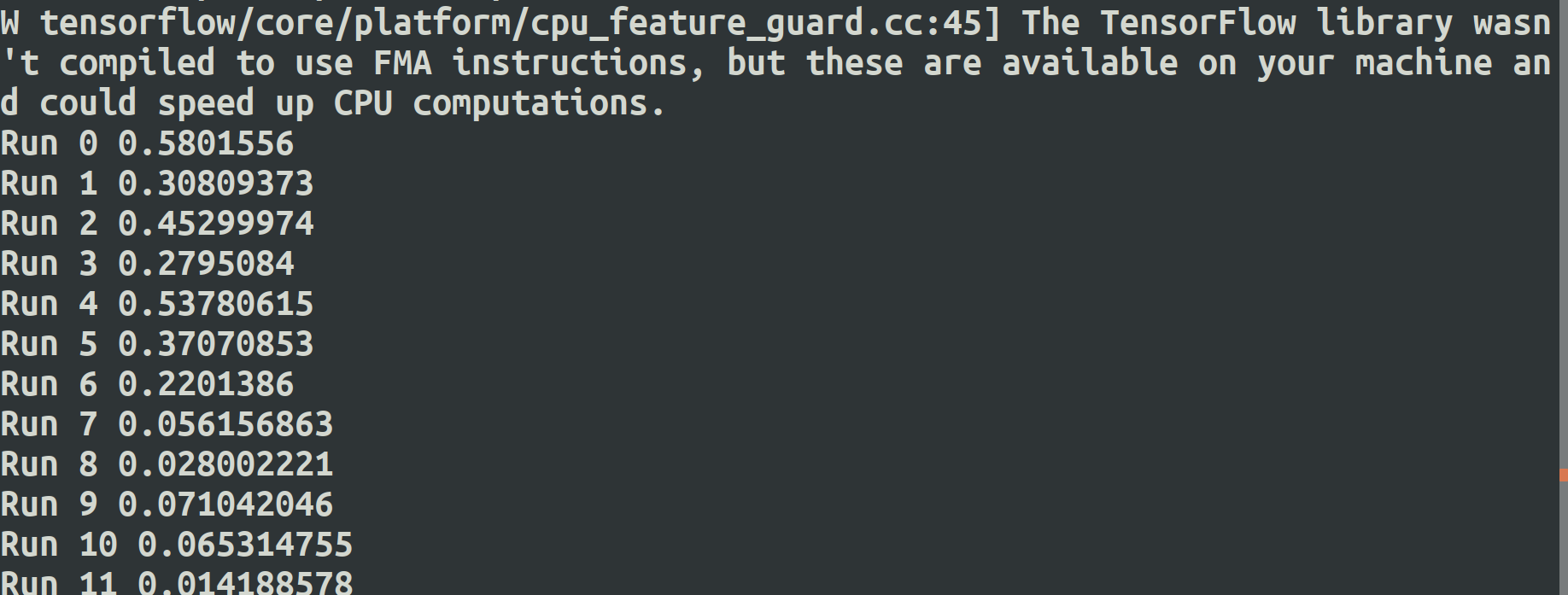时序预测一直是比较重要的研究问题,在统计学中我们有各种的模型来解决时间序列问题,但是最近几年比较火的深度学习中也有能解决时序预测问题的方法,另外在深度学习领域中时序预测算法可以解决自然语言问题等。
在网上找到了 tensorflow 中 RNN 和 LSTM 算法预测 sin 曲线的代码,效果不错。
LSTM:
#encoding:UTF-8 import random import numpy as np import tensorflow as tf from tensorflow.contrib.rnn.python.ops import core_rnn from tensorflow.contrib.rnn.python.ops import core_rnn_cell def build_data(n): xs = [] ys = [] for i in range(0, 2000): k = random.uniform(1, 50) x = [[np.sin(k + j)] for j in range(0, n)] y = [np.sin(k + n)] # x[i] = sin(k + i) (i = 0, 1, ..., n-1) # y[i] = sin(k + n) xs.append(x) ys.append(y) train_x = np.array(xs[0: 1500]) train_y = np.array(ys[0: 1500]) test_x = np.array(xs[1500:]) test_y = np.array(ys[1500:]) return (train_x, train_y, test_x, test_y) length = 10 time_step_size = length vector_size = 1 batch_size = 10 test_size = 10 # build data (train_x, train_y, test_x, test_y) = build_data(length) print(train_x.shape, train_y.shape, test_x.shape, test_y.shape) X = tf.placeholder("float", [None, length, vector_size]) Y = tf.placeholder("float", [None, 1]) # get lstm_size and output predicted value W = tf.Variable(tf.random_normal([10, 1], stddev=0.01)) B = tf.Variable(tf.random_normal([1], stddev=0.01)) def seq_predict_model(X, w, b, time_step_size, vector_size): # input X shape: [batch_size, time_step_size, vector_size] # transpose X to [time_step_size, batch_size, vector_size] X = tf.transpose(X, [1, 0, 2]) # reshape X to [time_step_size * batch_size, vector_size] X = tf.reshape(X, [-1, vector_size]) # split X, array[time_step_size], shape: [batch_size, vector_size] X = tf.split(X, time_step_size, 0) # LSTM model with state_size = 10 cell = core_rnn_cell.BasicLSTMCell(num_units=10, forget_bias=1.0, state_is_tuple=True) outputs, _states = core_rnn.static_rnn(cell, X, dtype=tf.float32) # Linear activation return tf.matmul(outputs[-1], w) + b, cell.state_size pred_y, _ = seq_predict_model(X, W, B, time_step_size, vector_size) loss = tf.square(tf.subtract(Y, pred_y)) train_op = tf.train.GradientDescentOptimizer(0.001).minimize(loss) with tf.Session() as sess: tf.global_variables_initializer().run() # train for i in range(50): # train for end in range(batch_size, len(train_x), batch_size): begin = end - batch_size x_value = train_x[begin: end] y_value = train_y[begin: end] sess.run(train_op, feed_dict={X: x_value, Y: y_value}) # randomly select validation set from test set test_indices = np.arange(len(test_x)) np.random.shuffle(test_indices) test_indices = test_indices[0: test_size] x_value = test_x[test_indices] y_value = test_y[test_indices] # eval in validation set val_loss = np.mean(sess.run(loss, feed_dict={X: x_value, Y: y_value})) print('Run %s' % i, val_loss) for b in range(0, len(test_x), test_size): x_value = test_x[b: b + test_size] y_value = test_y[b: b + test_size] pred = sess.run(pred_y, feed_dict={X: x_value}) for i in range(len(pred)): print(pred[i], y_value[i], pred[i] - y_value[i])

RNN :
import random import numpy as np import tensorflow as tf from tensorflow.contrib.rnn.python.ops import core_rnn from tensorflow.contrib.rnn.python.ops import core_rnn_cell def build_data(n): xs = [] ys = [] for i in range(0, 2000): k = random.uniform(1, 50) x = [[np.sin(k + j)] for j in range(0, n)] y = [np.sin(k + n)] # x[i] = sin(k + i) (i = 0, 1, ..., n-1) # y[i] = sin(k + n) xs.append(x) ys.append(y) train_x = np.array(xs[0: 1500]) train_y = np.array(ys[0: 1500]) test_x = np.array(xs[1500:]) test_y = np.array(ys[1500:]) return (train_x, train_y, test_x, test_y) length = 10 time_step_size = length vector_size = 1 batch_size = 10 test_size = 10 # build data (train_x, train_y, test_x, test_y) = build_data(length) print(train_x.shape, train_y.shape, test_x.shape, test_y.shape) X = tf.placeholder("float", [None, length, vector_size]) Y = tf.placeholder("float", [None, 1]) # get lstm_size and output predicted value W = tf.Variable(tf.random_normal([10, 1], stddev=0.01)) B = tf.Variable(tf.random_normal([1], stddev=0.01)) def seq_predict_model(X, w, b, time_step_size, vector_size): # input X shape: [batch_size, time_step_size, vector_size] # transpose X to [time_step_size, batch_size, vector_size] X = tf.transpose(X, [1, 0, 2]) # reshape X to [time_step_size * batch_size, vector_size] X = tf.reshape(X, [-1, vector_size]) # split X, array[time_step_size], shape: [batch_size, vector_size] X = tf.split(X, time_step_size, 0) cell = core_rnn_cell.BasicRNNCell(num_units=10) initial_state = tf.zeros([batch_size, cell.state_size]) outputs, _states = core_rnn.static_rnn(cell, X, initial_state=initial_state) # Linear activation return tf.matmul(outputs[-1], w) + b, cell.state_size pred_y, _ = seq_predict_model(X, W, B, time_step_size, vector_size) loss = tf.square(tf.subtract(Y, pred_y)) train_op = tf.train.GradientDescentOptimizer(0.001).minimize(loss) with tf.Session() as sess: tf.global_variables_initializer().run() # train for i in range(50): # train for end in range(batch_size, len(train_x), batch_size): begin = end - batch_size x_value = train_x[begin: end] y_value = train_y[begin: end] sess.run(train_op, feed_dict={X: x_value, Y: y_value}) # randomly select validation set from test set test_indices = np.arange(len(test_x)) np.random.shuffle(test_indices) test_indices = test_indices[0: test_size] x_value = test_x[test_indices] y_value = test_y[test_indices] # eval in validation set val_loss = np.mean(sess.run(loss, feed_dict={X: x_value, Y: y_value})) print('Run %s' % i, val_loss) for b in range(0, len(test_x), test_size): x_value = test_x[b: b + test_size] y_value = test_y[b: b + test_size] pred = sess.run(pred_y, feed_dict={X: x_value}) for i in range(len(pred)): print(pred[i], y_value[i], pred[i] - y_value[i])

-------------------------------------------------------------------